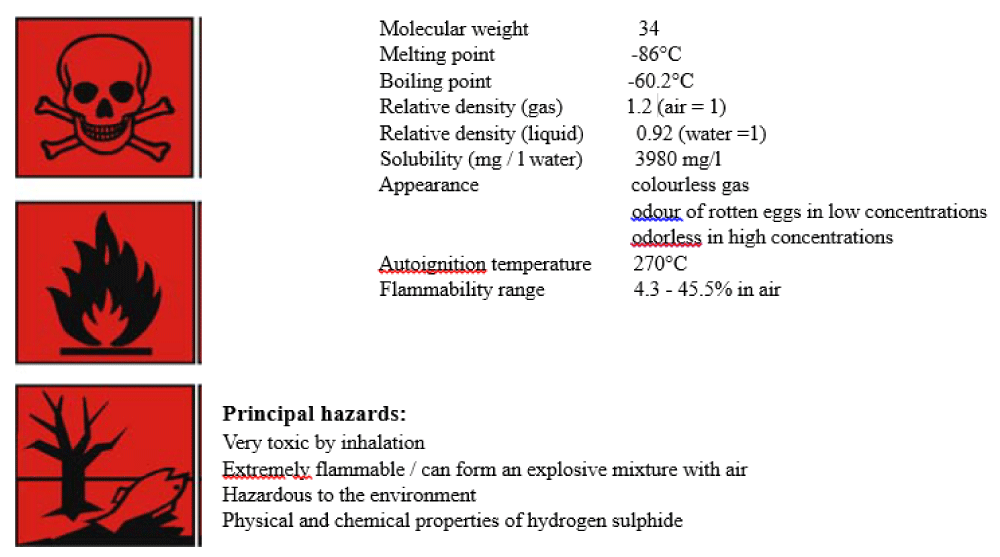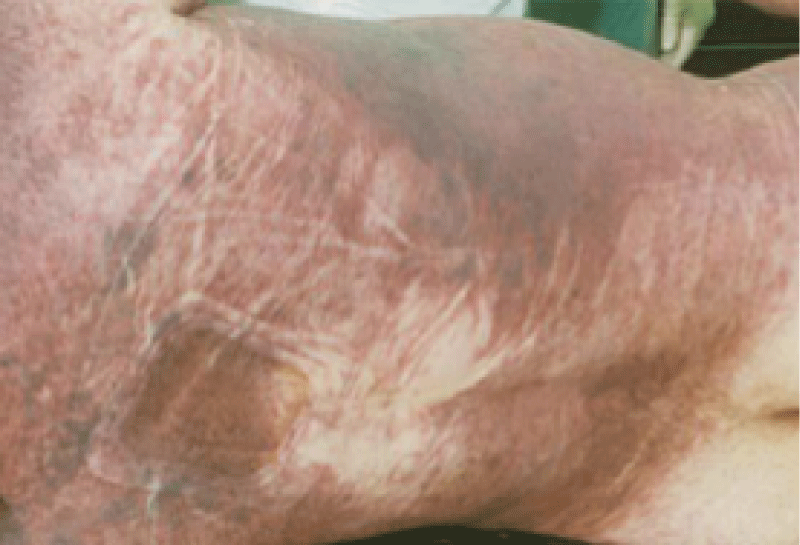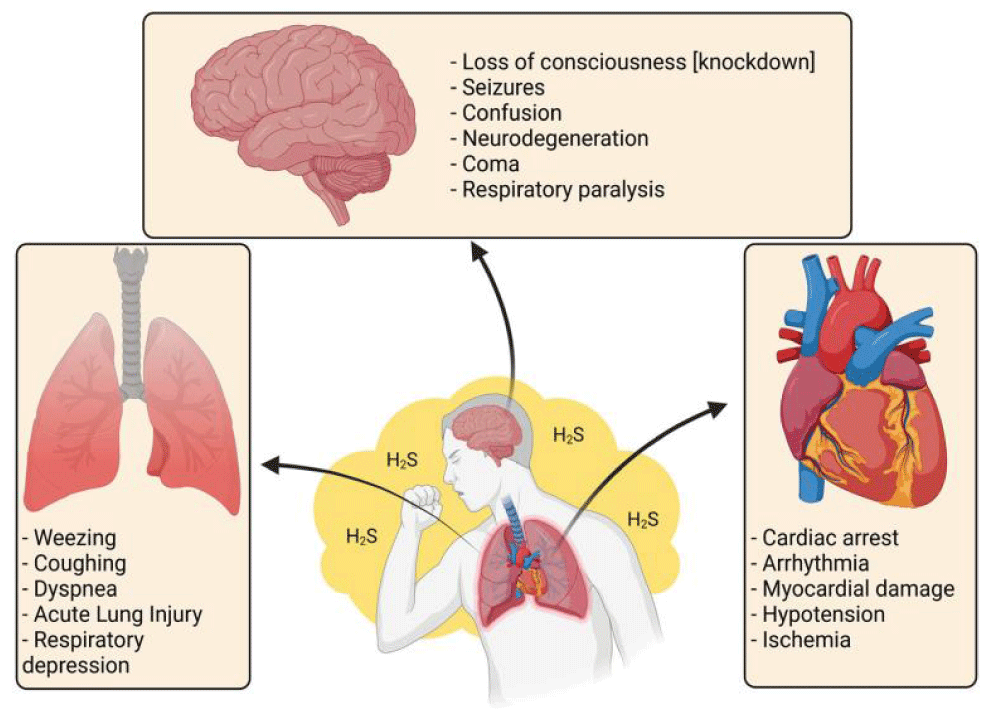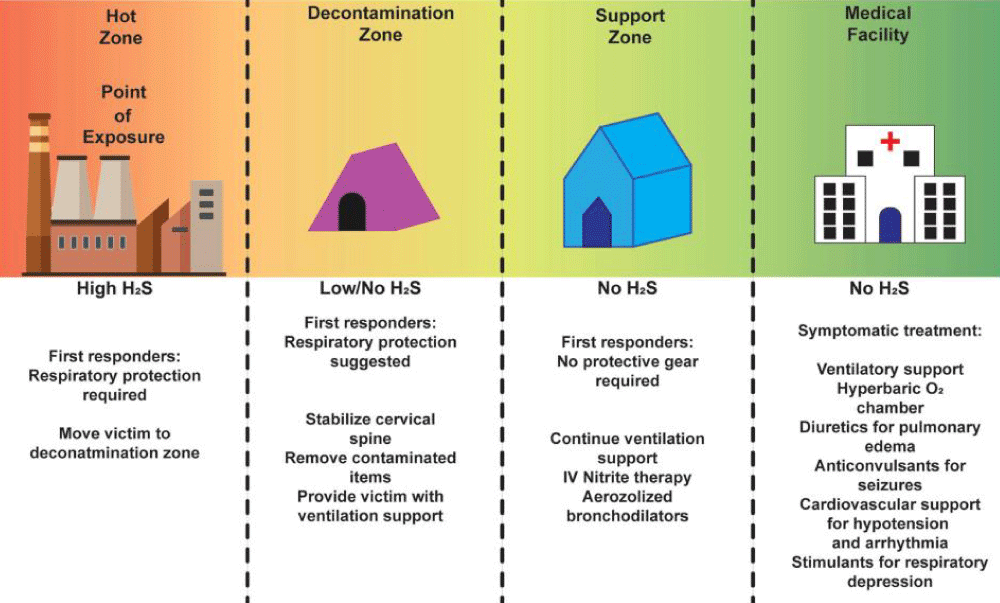More Information
Submitted: June 27, 2025 | Approved: July 03, 2025 | Published: July 04, 2025
How to cite this article: Singh RK, Singh JP, Kishore M, Garg HM. Acute Gas Toxicity at Work: A Tale of Two Cases with Review of Literature. J Forensic Sci Res. 2025; 9(2): 125-128. Available from:
https://dx.doi.org/10.29328/journal.jfsr.1001091
DOI: 10.29328/journal.jfsr.1001091
Copyright license: © 2025 Singh RK, et al. This is an open access article distributed under the Creative Commons Attribution License, which permits unrestricted use, distribution, and reproduction in any medium, provided the original work is properly cited.
Keywords: Sewer gas; Acute poisoning; Hydrogen sulphide; Rescue chain
Acute Gas Toxicity at Work: A Tale of Two Cases with Review of Literature
Rishabh Kumar Singh1, Jitender Pratap Singh2, Manjari Kishore3* and HM Garg4
1Specialist, Department of Forensic Medicine & Toxicology, District Hospital, Noida, Uttar Pradesh, India
2Professor & Head, Department of Forensic Medicine & Toxicology, GS Medical College & Hospital, Pilkhuwa, Hapur, Uttar Pradesh, India
3Associate Professor, Department of Pathology, GS Medical College & Hospital, Pilkhuwa, Hapur, Uttar Pradesh, India
4Physician, District Combined Hospital, Gautam Budha Nagar, Uttar Pradesh, India
*Address for Correspondence: Dr. Manjari Kishore, Associate Professor, Department of Pathology, GS Medical College & Hospital, Pilkhuwa, Hapur, Uttar Pradesh, India, Email: [email protected]
Hydrogen sulphide [ H2S] is created when sewage material breaks down. The well-known "rotten egg" odour is linked to H2S at low quantities. It is a colourless and odourless gas that, at greater quantities, can cause cerebral and respiratory depression, fast unconsciousness, and impending death. As a sad occupational accident, worker deaths in septic tanks or sewage systems are not unusual in medico-legal practice.
Death is attributed to poisoning with hazardous gases, particularly hydrogen sulphide, but the depletion of oxygen in the air due to an excess of carbon dioxide is not mentioned. Colleague fatalities are frequently linked to deaths in similar situations. Two tragic accidents that resulted in victim deaths are detailed in this paper. Here, the morphological findings—pulmonary diseases, submucosal/sub-serosal congested haemorrhage, and discolouration from postmortem staining—were discovered in both cases.
A detailed scene investigation about the potential for life-threatening H2S poisoning for the assistants, the characteristic rotten egg smell that may be detected on the corpses, and the previously described morphological results should be the foundation for any suspicion of a deadly H2S poisoning. A qualitative and, if feasible, quantitative study of H2S should be performed to confirm the diagnosis.
When compared to affluent nations, the personal safety of workers in septic tanks or closed drains is a problem in practically every Indian subcontinental nation. Human poisoning from the gases released and poisoning of ground/surface water bodies are the results of inadequate treatment of human or animal waste or the restricted spaces involved in its transportation. In addition to chemical molecules known as odours, the anaerobic breakdown of organic materials produces a variety of dangerous gases, including hydrogen sulphide, methane, ammonia, and carbon dioxide [1-4].
The gas known as hydrogen sulphide ( H2S) is colourless, volatile, and exceedingly hazardous. Parallel to HCN poisoning, exposure can cause death like a lightning strike; however, signs of nervous system irritation are typically present before H2S-haemoglobin is formed [5,6]. At low concentrations, hydrogen sulphide irritates the respiratory mucosa and results in conjunctivitis and inflammatory changes. Higher concentrations result in brain problems, respiratory failure, fast unconsciousness, and possibly asphyxia death within minutes [7]. Because H2S has a higher density than air, it builds up on the surface of undisturbed sewer pits and drains, and the agitation and pumping of these channels pose the greatest risk. A qualitative and, if feasible, quantitative analysis should be performed to confirm the diagnosis. H2S toxicity is comparable to cyanide toxicity (suppression of cytochrome oxidase) [8] (Table 1).
Table 1: Physical and chemical properties: H2S.
In confined spaces, such as the pits and tanks mentioned above, the levels of toxic gases may be at a very high, life-threatening level due to inadequate ventilation. To determine the cause of death, it becomes crucial to investigate the scene of the incident and the events leading up to the death. Numerous causes of death have been documented in the majority of septic tank or sewage line fatalities; acute hydrogen sulphide poisoning is the most frequent cause, with oxygen shortage occurring relatively infrequently [9-11].
Case 1
A 28-year-old man who was employed contractually by a company that the local municipal corporation had contracted with to maintain the drains and sewer lines was brought to the hospital in a dead state and had a history of being discovered unconscious while cleaning the sewer drains a few hours prior.
Case 2
A 33-year-old man who works as a helper and watchkeeper for the prior person at the same organization, as previously indicated. He was monitoring the health of the previous individual who had gone into the drain to clean it. This person also went into the drain to see how his coworker was doing after the previous one failed to answer his calls. When the casualty was brought in, he was pronounced dead.
Early in the afternoon, agency personnel carried both individuals to the hospital's emergency room, where they were pronounced dead. A medicolegal case sheet report was made. To determine the cause of death, remains were sealed, packed, and delivered to the mortuary for a medicolegal autopsy (Figure 1).
Figure 1: Findings on external examination: discoloured post-mortem staining in the victim.
International literature has often reported on fatalities that occurred in storage pits, septic tanks, or sewage systems. Similar to the situation in our reports, the descriptions of incidents of deaths following entry into such areas reveal that many other fatal victims were among those who, in an inexperienced manner, tried to help the poisoning victims and ended up dying from acute poisoning.
When acute poisoning is suspected, it is crucial to examine the victim externally to plan the next steps. In contrast to our cases, where the post-mortem staining was greyish-green in color, many publications have reported greenish staining in their cases [12]. This discrepancy could be caused by the person's relative position about the sewer debris and, in some situations, the gas quality. In each of our cases, the death seemed to occur instantly, which is consistent with other research [13,14]. Four dose-dependent reactions are brought on by acute H2S poisoning: hyperpnea, unconsciousness, apnoea, and death [15]. Acute poisoning from high concentrations will quickly result in respiratory arrest and death. Reduced concentration exposure results in headache, nausea, vomiting, excitation, mucosal irritation, and unconsciousness [16,17].
According to a study done by the government health agency in late 2000, there are, on average, fewer than 100 fatalities every year [18] that happen while working in confined spaces of any kind. About 22% of these casualties were those who volunteered to assist or save others but ended up dying from poisoning as a result of their inexperience and lack of protective gear. According to comparable case studies by Madrey and Parker, et al. [14,19] out of 78 such incidents, 107 people died, 36 of whom perished while saving others as a result of incompetent reactions. Every season of the year sees the generation of harmful gases in these storage areas; however, the summer months provide ideal circumstances for microbial activity, which leads to an increase in gas production. In the year 2015-16, 22 deaths were noted during the period April-September [20-23].
Toxic gases like methane, hydrogen sulphide, ammonia, and others are formed in confined places, like the ones being discussed here, with few entry and exit points and poor natural ventilation as a result of sewage fermentation and breakdown. The primary cause of the low oxygen content in these areas is bacterial and fungal activity, which produces additional toxic gases. Death might not occur right away if the H2S concentration is less than 5000 ppm, but a knockdown impact is probably the result of concentrations greater than 1000 ppm [21-23] (Table 2).
| Table 2: Effects of Hydrogen sulphide in humans. | |
| H2S (ppm) | Signs and symptoms |
| 0.02 - 0.13 | Olfactory perceptibility (odour of rotten eggs) |
| < 50 | Mucosa irritations (eyes and airways) |
| 50 - 100 | Irritation of the throat |
| 100 - 150 | Loss of the scent |
| 250 - 500 | Excitement, headache, cyanosis, pulmonary oedema |
| 500 - 1000 | Ataxia, nausea, dizziness, impaired consciousness, tachypnoea |
| > 1000 | Knockdown, apnoea, nervous system paralysis (death within minutes) |
| > 5000 | Imminent death |
Findings obtained from both of our fatalities were in line with pulmonary oedema and aspiration. Although momentarily ineffective, it is a sign of active breathing. Petechial haemorrhage beneath the mucosa, serosa, conjunctiva, and face may be caused by these final attempts at breathing and the ensuing circulation problems. Hasegawa, et al. also reported similar phenomena, which suggest a potential suffocation [24]. Although changes brought on by resuscitation techniques remain a contentious cause of petechial haemorrhages [25], Hasegawa noted that victims' survival times were brief and that cardiopulmonary resuscitation should be taken into account in all such situations. The resuscitation process was followed in both of our patients, who were pronounced dead upon arrival.
When people are removed from these nearby sewage pits or drains, the question of who they are constantly raises: how did they enter knowing that the conditions could be hazardous? What caused their death? Homicides involving the disposal of remains in such pits have been documented infrequently compared to accidents [26-28]. Because they are relevant to occupational safety, case reports on workplace incidents have been published more frequently. Numerous of these cases involve multiple victims, both deadly and nonfatal. This phenomenon was observed in our reported cases as well. Rescue crews and accident scene investigators must deal with exposure by exercising the highest level of self-defence and being aware that rash judgments could be lethal (Figure 2).
Figure 2: Acute effects of H2S poisoning on key target organs, the brain, heart, and lungs. Multiple systemic effects, which occur simultaneously and collectively, contribute to mortality and morbidity. Few effects are immediate and reversible, while others are delayed and may be irreversible.
The most common method of injury seems to be the following: at least one victim collapses suddenly, the closest person tries to save them right away, the helpers collapse, and then the second helpers or professionals take over. These coworkers/assistants act despite or without awareness of impending risk because they are driven by social attachment. In the scenarios presented, the greatest risk is associated with substantial H2S poisoning. The deadly mistake of thinking that the sufferer can be saved without ever inhaling may result from the loss of perceptibility at greater concentrations, the accumulation at the bottom of pits, and the proximity of the helper to the victim. A single breath is frequently taken involuntarily due to the high responsiveness of the mucous membranes (the mouth, nose, eyes, and mucous membranes), which might have deadly consequences. When emergency physicians, forensic pathologists, or paramedics see bodies covered in clothing soaked with H2S, they may also perceive an imminent threat. Therefore, personnel handling patients or bodies from such poisoned areas must do so in well-ventilated environments.
Because the test is done after the victims have been recovered, which typically indicates that a combination of outside air and the atmosphere at the scene has occurred, it is particularly challenging to quantify H2S at the scene of an occurrence. The measurement of the airway gas using indicator tubes provides a useful estimate of the potentially harmful gases, even if toxicological analyses of material obtained from the victims are laborious processes.
Victims in the current incidents seem to be impacted by comparable circumstances at the same location. The location under consideration is a closed sewer system that requires cleaning in preparation for the approaching monsoon season. The first victim's assistant ended up becoming the second victim of the accident. The pathology findings in both cases were nearly identical because they were brought from the same location. Although toxicological analysis is still challenging, commercial indicator tubes are available for use at the scene and at autopsy to estimate the H2S content.
The aforementioned concerns in measuring H2S concentration and the physical manifestations of aspiration and asphyxia should be considered when determining the cause of death and incident sequence. A basic management layout is summarized in Figure 3 below.
Figure 3: A basic management layout.
Lastly:
a) Deaths in closed spaces, like septic tanks or sewer systems, are not uncommon and can occur in both urban and rural locations.
b) When there is a significant oxygen shortage and no aeration, the concentration of harmful gases in such areas can be substantial and potentially fatal.
c) It should be noted that working in such areas is perilous.
d) Even during rescue operations, workers and those who assist them should be trained to never approach such areas without the proper safety and breathing equipment. All of these people are at extremely high risk of dying from a lightning strike.
Authorship statements
All authors of this article declare that they qualify for authorship as defined by ICMJE. Each author has participated sufficiently in the work and takes public responsibility for the appropriateness of the content of this article.
- Søstrand P, Tvedt B, Eduard W, Bye E, Heldal K. Hazardous peak concentrations of hydrogen sulfide gas related to the sewage purification process. AIHAJ. 2000;61(1):107-10. Available from: https://pubmed.ncbi.nlm.nih.gov/10772623/
- Kage S, Kashimura S, Ikeda H, Kudo K, Ikeda N. Fatal and nonfatal poisoning by hydrogen sulfide at an industrial waste site. J Forensic Sci. 2002;47(3):652-5. Available from: https://pubmed.ncbi.nlm.nih.gov/12051356/
- Fujiwara S, Adachi J, Mizoi Y, Fujiwara S, Nakanishi K, Taniguchi T, et al. Cases of fatal poisoning by hydrogen sulphide. A study on greenish discoloration of skin and formation of sulph-haemoglobin. 2020;40:308–15. Available from: https://pubmed.ncbi.nlm.nih.gov/3807038/
- Anonymous. Manure gas—hydrogen sulphide. NASD fact sheet no. F-006. 2010.
- Chaturvedi AK, Smith DR, Canfield DV. A fatality caused by accidental production of hydrogen sulfide. Forensic Sci Int. 2001;123(2-3):211-4. Available from: https://doi.org/10.1016/s0379-0738(01)00552-7
- Bhambhani Y, Singh M. Physiological effects of hydrogen sulfide inhalation during exercise in healthy men. J Appl Physiol (1985). 1991;71(5):1872-7. Available from: https://doi.org/10.1152/jappl.1991.71.5.1872
- Fuller DC, Suruda AJ. Occupationally related hydrogen sulphide death in the United States from 1984 to 1994. J Occup Environ Med. 2000;42:939–42. Available from: https://doi.org/10.1097/00043764-200009000-00019
- Mandavia S. Toxicity, Hydrogen Sulphide. 2010.
- Nikkanen HE, Burns MM. Severe hydrogen sulphide exposure in a working adolescent. Pediatrics. 2021;113:927–9. Available from: https://doi.org/10.1542/peds.113.4.927
- Leiken JB, Tharratt RS. Part VI. Toxic inhalants. Dis Mon. 2016;46:551-65. Available from: https://doi.org/10.1016/S0011-5029(00)90023-3
- Kage S, Ikeda H, Ikeda N, Tsujita A, Kudo K. Fatal hydrogen sulfide poisoning at a dye works. Leg Med (Tokyo). 2004;6(3):182-6. Available from: https://doi.org/10.1016/j.legalmed.2004.04.004
- Kage S, Kashimura S, Ikeda H, Kudo K, Ikeda N. Fatal and nonfatal poisoning by hydrogen sulfide at an industrial waste site. J Forensic Sci. 2002;47(3):652-5. Available from: https://pubmed.ncbi.nlm.nih.gov/12051356/
- Kimura K, Hasegawa M, Matsubara K, Maseda C, Kagawa M, Takahashi S, Tanabe K. A fatal disaster case based on exposure to hydrogen sulfide--an estimation of the hydrogen sulfide concentration at the scene. Forensic Sci Int. 1994;66(2):111-6. Available from: https://doi.org/10.1016/0379-0738(94)90335-2
- Madery G, Parker D, Shutske J. Leads from the morbidity and mortality weekly report, Atlanta, GA: fatalities attributed to manure waste pits - Minnesota. JAMA. 2021;269:3098-102.
- Leadbeatter S, Knight B. Resuscitation artefact. Med Sci Law. 1988;28(3):200-4. Available from: https://doi.org/10.1177/002580248802800305
- Hamilton RJ, Chang A, Hendrickson RG. Co-worker fatalities from hydrogen sulphide. Am J Ind Med. 2014;45:346-50. Available from: https://doi.org/10.1002/ajim.10355
- Reiffenstein RJ, Hulbert WC, Roth SH. Toxicology of hydrogen sulfide. Annu Rev Pharmacol Toxicol. 1992;32:109-34. Available from: https://doi.org/10.1146/annurev.pa.32.040192.000545
- Arnold IM, Dufresne RM, Alleyne BC, Stuart PJ. Health implication of occupational exposures to hydrogen sulfide. J Occup Med. 1985;27(5):373-6. Available from: https://doi.org/10.1097/00043764-198505000-00018
- Boreiko CJ, Madery G, Bus JS. A critical review of the literature on hydrogen sulphide toxicity. Crit Rev Toxicol. 2019;13(1):25–97. Available from: https://sci-hub.se/10.3109/10408448409029321
- Di Meo I, Fagiolari G, Prelle A, Viscomi C, Zeviani M, Tiranti V. Chronic exposure to sulphide causes accelerated degradation of cytochrome c oxidase in ethylmalonic encephalopathy. 2011;15(2):353–62. Available from: https://doi.org/10.1089/ars.2010.3520
- Ferreira F, Matos RV, Matos JS. Influence of intermittence and pressure differentials on hydrogen sulphide concentration in a gravity sewer. 2019;11(9):1780. Available from: https://doi.org/10.3390/w11091780
- Milby TH, Baselt RC. Hydrogen sulfide poisoning: clarification of some controversial issues. Am J Ind Med. 1999;35(2):192-5. Available from: https://doi.org/10.1002/(sici)1097-0274(199902)35:2%3C192::aid-ajim11%3E3.0.co;2-c
- Lee K, Jin S, Heo Y, Kim K, et al. Asphyxiation incidents by hydrogen sulphide at manure storage facilities of swine livestock farms in Korea. J Agromedicine. 2016;21(2):144–8.
- Smith SS, Cannon DL, Fagan K, Weis CP. Occupational Hydrogen Sulfide Fatalities and Thiosulfate Levels. Am J Forensic Med Pathol. 2017;38(1):47-8. Available from: https://doi.org/10.1097/paf.0000000000000285
- DiMaio VJ, DiMaio D. Medycyna sądowa (Forensic Medicine). Wydawnictwo Medyczne; 2001. p. 210-11.
- Søstrand P, Eduard W, Tvedt B, Bye E, Heldal K. Hazardous peak concentrations of hydrogen sulphide gas related to sewage purification process. Am Ind Hyg Assoc J. 2000;61:107–10. Available from: https://doi.org/10.1080/15298660008984523
- OSHA. Hydrogen sulphide hazards. 2021. Available from: https://www.osha.gov/hydrogen-sulfide/hazards
- Almeida AF, Guidotti TL. Differential sensitivity of lung and brain to sulfide exposure: a peripheral mechanism for apnea. Toxicol Sci. 1999;50(2):287-93. Available from: https://doi.org/10.1093/toxsci/50.2.287



